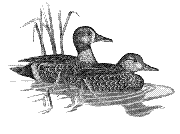US Fish & Wildlife Service
Date of this Version
January 1991
Abstract
Aside from humans, no other organism has the capacity to modify its environment as much as the beaver. In doing so, beaver create wetlands that provide valuable waterfowl habitats. Because beavers are widely distributed in North America (Fig. 1), beaver ponds can benefit waterfowl during breeding, migrating, and wintering periods. Mismanaged beaver populations, however, can severely degrade riparian habitats and become a costly problem. The key to successfully managing beaver for waterfowl benefits is understanding the values of beaver ponds in meeting the seasonal needs of waterfowl. Beaver populations must then be managed to provide these benefits in a self-sustaining manner compatible with the carrying capacity of the habitat.
Before the arrival of Europeans, 60–400 million beavers occupied 5.8 million square miles of North America. But by 1900, beavers had been so severely over-exploited by trappers and hunters that they were almost extinct. Today, beaver populations are on the upswing: 6 million to 12 million animals occupy diverse habitats ranging from the boreal forests of Canada south to the Texas gulf coast, and from California’s Central Valley east to the Atlantic seaboard. This recent population increase is a testament to the resiliency of beaver populations and their responsiveness to management techniques. I review some techniques useful for managing beaver populations and enhancing beaver habitats to benefit waterfowl, and explain the ecological relations and characteristics that make beaver ponds attractive waterfowl habitats.



Comments
Published in Diana H. Cross and Paul Vohs (eds.) Waterfowl Management Handbook. Fort Collins, CO: U.S. Fish and Wildlife Service, 1988. Online at http://www.nwrc.usgs.gov/wdb/pub/wmh/contents.html